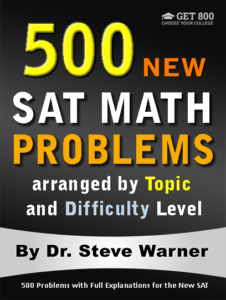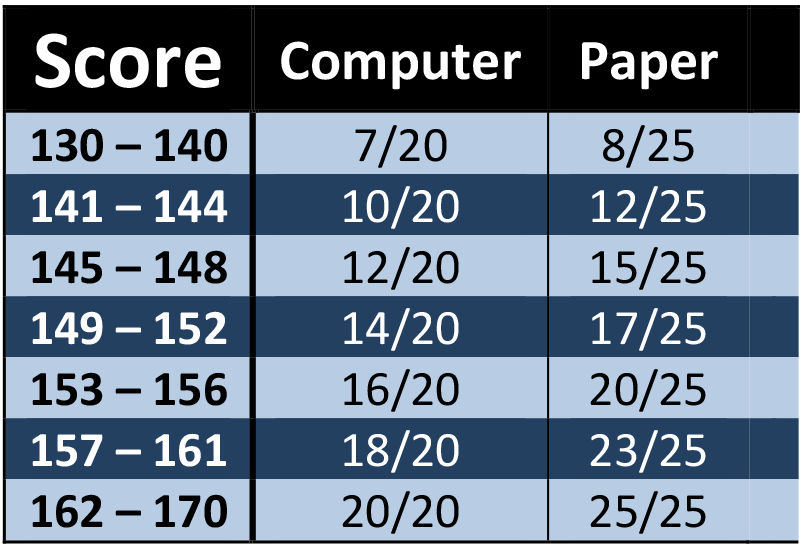
500 New SAT Math Problems
Just 19.99 on Amazon
Hi everyone! The latest edition of 500 New SAT Math Problems is now available in paperback from Amazon. This edition just has been modified from the previous edition to account for the changes on the Digital SAT.
The paperback is now on sale on Amazon for only $19.99. Note that once the sale ends (by the end of today), the price of this book will go up to $42.99.
The promotion has ended. Thanks to everyone who participated. The book is now available at its regular price here: 500 New SAT Math Problems
If you have any questions, feel free to contact me at steve@SATPrepGet800.com
Thank you all for your continued support!
A Trick For Free Two Day Shipping
I would like to finish this post with a little trick you can use to get free 2 day shipping on any of the books you decide to purchase without making any additional purchases. If you have never used Amazon Prime you can sign up for a free month using the following link.
Sign Up For Amazon Prime For Free
If you have already had a free trial of Amazon Prime you can simply open up a new Amazon account to get a new free trial. It just takes a few minutes! You will need to use a different email address than the one you usually use.
This next part is very important! After you finish your transaction, go to your Account, select “Manage my prime membership,” and turn off the recurring billing. This way in a month’s time Amazon will not start charging you for the service.
After shutting off the recurring billing you will still continue to receive the benefit of free 2 day shipping for one month. This means that as long as you use this new Amazon account for your purchases you can do all of your shopping on Amazon for the next month without having to worry about placing minimum orders to get free shipping.
Just be aware that certain products from outside sellers do not always qualify for free shipping, so please always check over your bill carefully before you check out.
Well I hope you decide to take advantage of this very special offer, or at the very least I hope you will benefit from my Amazon “free 2 day shipping trick.” Here is the link one more time:
Sign Up For Amazon Prime For Free
If you think your friends might be interested in this special offer, please share it with them on Facebook:
Thank you all for your continued support!

How Many Questions Should You Be Attempting
In Each GRE Math Section?
The last couple of days I explained why most students should not be attempting every math question on the SAT and ACT, and I gave tables displaying how many questions they should be answering based upon their current PSAT/SAT or ACT math score. To see that information, follow these links:
Today I will give you similar information for the GRE. As for the SAT and ACT, many students can increase their GRE math score by decreasing the number of questions they attempt to solve. Your goal when taking the GRE should be to maximize your score, and not to solve every single problem. If you are going for a perfect 140, then of course you will need to solve every problem, but for most of us, we won’t have to do that.
The following chart gives a general guideline for how many questions you should be attempting in each math section. The leftmost column is your latest score on an official practice test. The middle column shows how many questions you should answer in each math section if you are taking the computer based test. The rightmost column shows how many questions you should answer in each math section if you are taking the paper based test.

For example, a student with a current score of 155 on the computer based test should attempt about 16 questions in each math section. This is just a general guideline. Of course it can be fine-tuned. As a simple example, if you are particularly strong at Arithmetic problems, but very weak at Geometry problems, then you may want to try every Arithmetic problem no matter where it appears, and you may want to reduce the number of Geometry problems you attempt.
Remember that there is no guessing penalty on the GRE, so you should not leave any questions blank. This does not mean you should attempt every question. It means that if you are running out of time make sure you fill in answers for all the questions you did not have time to attempt.
For example, if you are currently scoring a 151 on the computer based test, then it is possible you will only be attempting about 14 questions in each section. Therefore, when you are running out of time you should fill in answers for the remaining 6 problems. If you happen to get a chance to attempt some of them, you can always change your answer. But make sure those answers are filled in before the test ends!
If you are currently preparing for the GRE, you may want to take a look at the 320 GRE Math Problems.

How Many Questions Should You Be Attempting
In Each ACT Math Section?
Yesterday I explained why most students should not be attempting every math question on the SAT, and I gave a table displaying how many questions they should be answering based upon their current PSAT or SAT math score. To see that information, follow this link:
How Many Questions Should You Be Attempting In Each SAT Math Section
Today I will give you similar information for the ACT. As for the SAT, many students can increase their ACT math score by decreasing the number of questions they attempt to solve. Your goal when taking the ACT should be to maximize your score, and not to solve every single problem. If you are going for a perfect 36, then of course you will need to solve every problem, but for most of us, we won’t have to do that.
There is only one 60 question math section on the ACT. You should first make sure that you know what you got on your last official ACT practice test or actual ACT (whichever you took last). What follows is a general goal you should go for when taking the exam.

For example, a student with a current score of 22 should attempt 40 of the 60 questions. This could be the first 40 questions, but it is okay to skip a few here and there and try some that come a little later instead.
This is just a general guideline. Of course it can be fine tuned. As a simple example, if you are particularly strong at algebra problems, but very weak at geometry problems, then you may want to try every algebra problem no matter where it appears, and you may want to reduce the number of geometry problems you attempt.
Important note: There is no guessing penalty on the ACT. You should therefore fill in an answer for every question, even those questions that you do not attempt to solve. Simply take guesses for those last questions before time is up.
If you are currently preparing for the ACT, you may want to take a look at my series of ACT math books.


